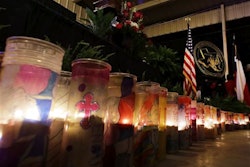CAMERON, La. (AP) — A proposed liquefied natural gas export terminal in Cameron Parish would not significantly damage the environment, the Federal Energy Regulatory Commission staff said Wednesday. The conclusion also applies to 21 miles of pipeline and associated facilities proposed for Cameron, Calcasieu and Beauregard parishes.
The project has adequate plans to compensate for filling in 213 acres of wetlands, according to an environmental impact study released Wednesday. It says those include using dredged material to turn an area of open water to brackish marsh and buying credits from approved mitigation banks.
The report by FERC environmental staffers concluded that construction and operation won't affect any of the eight threatened or endangered species in the area, though it said surveys for the red-cockaded woodpecker should be updated within a year before construction.
Cameron LNG LLC and Cameron Interstate Pipeline LLC have included adequate safety features in their plans, it said.
And it said the firms plan to avoid disturbing the beds of sensitive and major water bodies by drilling horizontally underneath them for its 42-inch pipeline.
U.S. Rep. Charles W. Boustany Jr., R-La., and U.S. Sen. Mary Landrieu, D-La., sent out statements praising the action.
"South Louisiana is fast-becoming the LNG capital of the world," Boustany said.
Landrieu said, "This will create thousands of high-paying jobs in Southwest Louisiana, provide American exporters critical access to new markets, and position America as an energy superpower."
The firms are subsidiaries of Sempra International LLC of San Diego, Calif. Sempra wants to add liquefaction plants and other facilities to convert its import terminal into an export terminal, and said in February that it had received the final Energy Department it needs.
The expansion would cost up to $10 billion, with up to $7 billion of it in capital construction costs.
The environmental staff recommended that permits include a requirement for certified statements that Cameron's staff either has been or will be trained in environmental mitigation measures before starting construction and restoration.
The various federal agencies that ultimately will decide whether to grant the application are not bound by the recommendations.






















